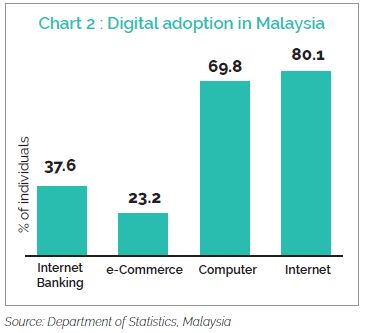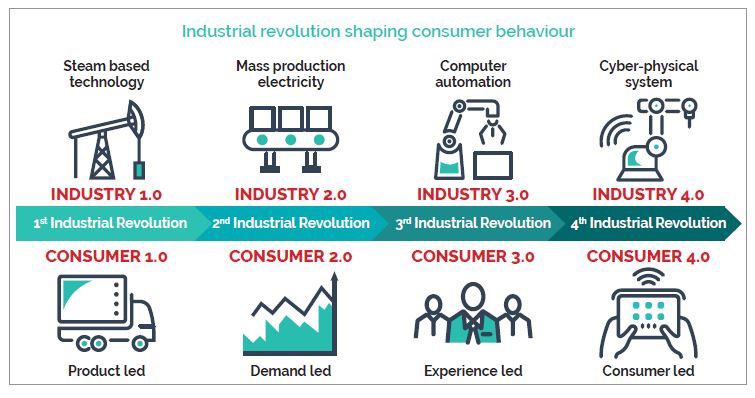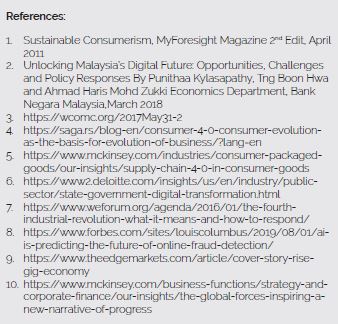by | Azmil Mohd Amin, azmil@might.org.my
In myForesight®’s 2nd edition magazine published back in 2011, we wrote about sustainable consumption. In the article, we touched on the frame and basis of an upcoming trend in consumerism. In short, sustainable consumption was discussed as a key factor to cultivate sustainable solutions based on informed purchasing decisions and a tilt in consumer behaviours.
In all sectors of the economy, governments, businesses and the global society’s interests span almost every line of consumerism. All of these sectors are always looking for effective turnarounds from sustainable consumerism practices and solutions. Governments and businesses constantly rely upon new technologies as the centres of consumerism and innovation.
Of these, consumerism is coming into view as a critical measure to fulfil every sector’s development needs. Educating all the agents of change to promote efficiency in the manufacturing of products and delivery of services is so important to reduce wasteful consumption.
Today, it has become a pressing matter that demands immediate attention. Fast forward 2019, a change of pace in the nature of consumerism, its dynamic, digital, population growth and the society’s purchasing power underscores the potential impact on consumerism in ways never seen before. Domestically and globally, consumerism has multiplier effects on the economy.
Here, we aim to pinpoint the effects of emerging digital and Industry 4.0 trends that will shape the economics of consumerism over the next decade. More broadly, this article explores their makeup and detail the actions that both public and private actors can act on to make the most of the opportunities that these trends carry along with them.
Against the backdrop of cyber-physical systems, the creation of Consumer 4.0 presents a big leap in the supply and demand of goods and services. This is also creating new business models.
How would these trends influence and shape the future landscape of domestic trade? What are the challenges? What are new measures that need to be put in place to cultivate a shift in thinking across governments and consumer groups? Certainly, awareness of all the trends is a key discussion matter that needs to be led by both public and private actors.
Trends that emerge and may shape the future of consumerism
Digitalisation
Digitalisation is an unstoppable trend. Storing information on cloud and physical devices such as diamonds and biological apparatus, e.g. DNA will be the sweeping digital trend in the 21st century.
Meanwhile, communicating and socialising via a virtual world using avatars, or Reality 2.0 are showing up in making the digital world a buzzing and populous space. These changes are spaces to watch, in which a lot of innovation activities take place. As a consequence, new consumerism attitudes have become a threat to traditional business models.
Purchasing of products and services are no longer carried out at physical stores. These activities however will largely take place at digital storefronts of trading apps and online shopping sites.
For example, H&M’s push notifications use past purchases to suggest additional items.
In the Malaysian context, the country’s digital adoption must vastly improve to chart faster progress in order to catch up with the digital economy.
Although consumers’ use of digital services such as e-commerce and internet banking is a prevailing trend, the figures drawn by the Department of Statistics Malaysia (DOSM) showed that it is still not gathering enough pace where digital activities remain relatively low (Chart 2).
The majority of internet users in Malaysia are engrossed in the consumption of content (e.g. downloading movies/ music, social media and games), without really taking part in productive activities such as the creation of new content (e.g. mobile applications) to generate any real economic values.


Decentralisation
Decentralisation is creating a smarter and more connected business sector. Business deals involving purchasers and suppliers (digital currency) will soon be separated from the production of products and delivery of services by SMEs and individuals.
On the whole, machine learning and systems anchored around Artificial Intelligence (AI) competencies are taking over the decision making process. Technology is delivering astounding advances. In view of this, the adoption of Blockchain is pointing toward a transparent, authentic and trustworthy global supply chain. Walmart’s veggie tracker, uses blockchain to monitor its food supply chain. Machine learning and AI are inching closer toward real adoption. An example of this is the Radio-frequency identification (RFID) technology.
It allows big chain stores the ability to oversee cattle’s movement throughout the supply chain from farm to fork. This not only enables retailers to know when a consumer has used up a product, but it also makes the product comprehensibly traceable in respect of its origin, how it was produced, by whom and to what standards.
Autonomous & Inter-connected systems
The proliferation of wearables is getting more access to patient information. Information collected by these devices allow healthcare industry players to zero in on patient behaviour to improve healthcare services and build a lead in technology over their competitors. This is aided by a decision making process largely configured around machine learning or AI systems’ well-rounded capability. To understand the technology trend in the broadest terms, Google recently launched its medical centre in the US. It is a first of its kind treatment facility where patients who disagree with their regular doctor’s clinical diagnoses can come and freely pursue the selfdiagnosis that they have googled on the internet.
Blurring boundaries
Humans and machines will create bright interaction experiences in digital and physical environments. As such, machines are beginning to encroach into nonroutine cognitive domains. Machine learning, knowledge representation, M2M communication, automated reasoning and virtual reality are formidable exhibits of what machines are capable of. The convergence of both cyber and physical worlds seeks to create ‘smart’ objects in the forms of IoT, 3D printing, VR and AR.
A further example of this are mobile robots that enable the automation of cart handling, conveying and RFID scanning. All these can be done without requiring major changes to the existing operating infrastructure.
Collaborative solutions
Distance will matter less in the future technology landscape. ‘Digital twins’ enable machine operation in one country to be mirrored by the display of its ‘twin’ in real-time in another location.
The importance of location will dilute too. Mobile platforms will enable virtual face-to-face communication apart from allowing a vast majority of the workforce to work remotely from any parts of the world. So much so, a US based pizza chain is currently exploring the possibility of testing a pizza delivery robot in New Zealand.
Resources
The world’s resource equation is changing as technology,expands resource availability and productivity. We’re seeing new growth dynamics where the size of resources will no longer guarantee success. Redefining what entrepreneurs can do, crowd-sourcing platforms offer start-ups the viability to gather the resources they need at the convenience of their digital marketing channels.
Technologies are combining in new ways, with the potential to reduce resource intensity dramatically. Vehicle electrification, ride sharing, driverless cars, vehicle-to-vehicle communications, and the use of new materials are rapidly coming together tipping the scales of the world’s resources. This however, is barely scratching the surface of what a new suite of connected technologies can do to impact the way we use our resources in the years to come.
The sharing economy
Khazanah Research Institute pointed out that there has been a steady increase in the number of self-employed citizens in urban areas since 2010. Since 1995, selfemployed citizens have accounted for up to 12% of urban employment, but this has since increased to almost 16% in 2016, equivalent to 1.7 million people with an increase of more than 760,000 since 2010. However, fresh questions arise about governments’ revenue as self-employed citizens’ activities are hardly visible.
Customisation
Customisation will be a major theme in the future technology-led economic landscape. Customisation allows greater insights to be gathered on customer utilisation through real-time feedback. Consumers on the other hand play an active role in designing products and services through creative engagements designed by businesses.
The next stream of innovation will enable businesses to meet fast evolving market preferences through mass customisation. One prime example of mass customisation is Adidas’ recent take on its latest shoe technology. A leader in sports apparel and accessories, Adidas has announced plans to exploit an innovative approach to shoe science and taking it to the next level by leveraging on 3D Printing technologies (4D Digital Light Synthesis) to create highly customisable shoes.
Moving forward: Impact and implications to governments
Having said the above consequences, governments must be ready to adapt and change as the terms of the digital economy are changing, government revenue will be impacted too.
Overall, we are not just being invaded by new technologies, we’re experiencing a combination of technology explosion where interconnected networks of businesses, platforms, consumers, and suppliers are turning consumerism on its head.
The gig and sharing economies too are growing, while ahead of some trends, this is resulting in a business ecosystem revolution. For the public service sector, automation across a host of government functions will increase efficiency. As a result of this, many job functions will need to be revisited where reskilling and redesigning job functions within the sector needs to be carried out. Despite this, the public service sector can bring about greater personalisation and decentralisation when the applications of new technologies become more widespread.
Meanwhile, privacy and national security continue to weigh heavily on consumer sentiment ahead of the next technological breakthroughs. Significant tension runs through the society and the direction of these new technologies under way remains unclear. Yet, there are also encouraging signs amid growing acceptance of these new technologies. Nonetheless, confronting these dynamics with respect to data protection and collection can help us draft a better strategy and forge a brighter future.
Moving closer to the mainstream are new technologies such as AI, AR, drones, robotics, 3D printing. However, how long can traditional sources of competitive advantage survive in the face of technological shifts? How will changing consumer and societal expectations affect conservative business models? To cooperate in tandem with what upcoming technology trends can unleash, we would like to bring into view three key considerations.
1. The spread of digital products and services is surging. Therefore, it is important to keep abreast of the list of opportunities and challenges of tomorrow’s global business landscape.
2. Individually and in confluence with other trends, traditional trade is undergoing international integration. What does it mean for local businesses? And what are the changes needed to amplify the need for this transition?
3. New technologies are driving global consumption and favourable demographics are fuelling a rise in opportunities and potential revenues. But what does it take to navigate global complexities in order to move up the value chain?
Last but not least, disruptive technologies have become increasingly evident. Soon, they will reshape consumerism as a whole. Despite substantial changes over the past decade, are we ready to keep up with the pace of change and transition to sustainable practices and solutions at international scale to grow?
While the benefits of disruptive technologies changing consumerism are under intense scrutiny, the opportunity remains enormous. As a developing nation, global forces at work require us to realign our economic footprint and react to resolve our future. Given technology’s role in a wide range of consumer goods and services, we must remain proactive without being too wary of avoiding technology turnaround stunting our economic growth and improve our ability to reallocate resources to face up to imminent global transition.











